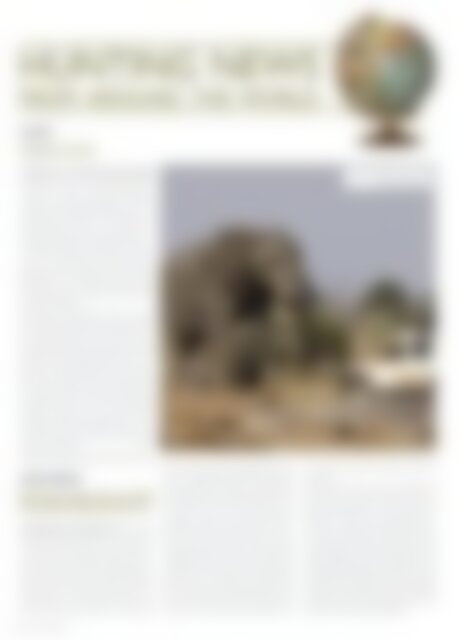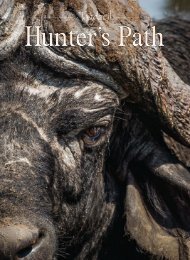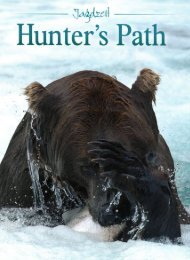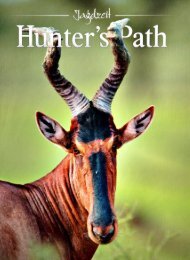Create successful ePaper yourself
Turn your PDF publications into a flip-book with our unique Google optimized e-Paper software.
HUNTING NEWS<br />
FROM AROUND THE WORLD<br />
AFRICA<br />
Elephant Census<br />
THE RESULTS OF THE FIRST AFRICAN-WIDE<br />
elephant survey are now available. Between 2007<br />
and 2014, the number of savannah elephant decreased<br />
by one third. The population in 2014 was<br />
estimated to be 350,000 to 400,000 animals. Additionally,<br />
elephant numbers in the rainforests of<br />
Central Africa have fallen even more drastically.<br />
Funded primarily by a grant of seven million US dollars<br />
from Microsoft founder Paul Allen, the counts<br />
from the air involved ninety scientists working in<br />
eighteen countries. With eighty-one aircraft and the<br />
participation of many wildlife protection agencies<br />
and relief organizations, samples were determined<br />
and then extrapolated.<br />
According to the responsible scientists, the causes<br />
of the population decreases are poaching and the<br />
loss of natural habitats for the pachyderms. Human<br />
population growth and the continual spread<br />
of agriculture are causing suitable habitats to shrink.<br />
Above all, increasing cattle grazing, mostly by migrant<br />
herds, makes conservation efforts difficult.<br />
The scientists counted more than three million cattle<br />
in elephant habitat. They also spotted hundreds<br />
of poacher camps from the air. Actual elephant<br />
poaching is usually done by young men from the<br />
local villages. Afterwards, smuggler rings run by organized<br />
crime transport the ivory to Asia, especially<br />
to China and Vietnam. <br />
rdb<br />
How many elephant are there?<br />
Photo: iStockphoto<br />
TROPHY HUNTING<br />
Banning Trophy Hunting Will<br />
Exacerbate Biodiversity Loss<br />
INTERNATIONAL PRESSURE TO ban trophy<br />
hunting is increasing. However, three scientists from<br />
Finnish, British and Australian universities argue in<br />
an article in Trends in Ecology and Evolution (Vol. 31,<br />
Issue 2, December 30, 2015), that hunting can be an<br />
important conservation tool, and that it can benefit<br />
biodiversity conservation and local people. “The<br />
hunting industry is characterized by many problems<br />
and shortcomings, in particular in Africa,” state<br />
Di Minin, Leader-Williams and Bradshaw, the three<br />
authors. “Nevertheless trophy hunting can help address<br />
the ongoing loss of species.” Therefore, blanket<br />
hunting bans would exacerbate biodiversity loss.<br />
The authors see three main reasons for this. First,<br />
financial resources for conservation are limited in<br />
developing countries. Hence, wildlife use is necessary<br />
to generate enough funding to support<br />
meaningful conservation success over large areas.<br />
Sustainable hunting can create important incentives<br />
for biodiversity conservation in areas where photographic<br />
tourism is not possible or not economically<br />
viable. If revenue cannot be generated from trophy<br />
hunting, natural habitats will be transformed to<br />
other forms of land use that provide higher return<br />
on investments, but that have negative impacts on<br />
biodiversity.<br />
Second, trophy hunting can have a smaller footprint<br />
than other tourism in terms of carbon emissions, infrastructure<br />
development, and personnel, and can<br />
generate more revenue from a lower volume of tourist<br />
hunters. Compared with photographic tourism,<br />
the trophy-hunting industry relies on fewer tourist<br />
hunters, because the income generated per hunter<br />
is higher. Additionally, hunters are interested in maintaining<br />
good quality habitat for the simple reason that<br />
the caliber of the animals harvested therein is also high.<br />
Finally, hunters are prepared to hunt in areas lacking<br />
attractive scenery, and that require less infrastructure,<br />
therefore minimizing habitat degradation.<br />
4 | Hunter´s <strong>Path</strong> 4/2016











